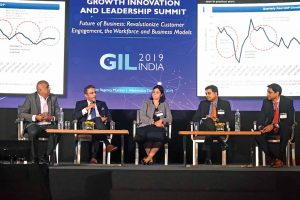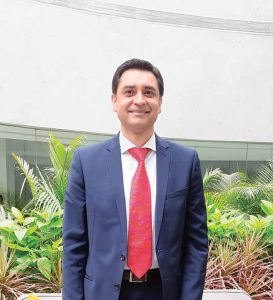Frost & Sullivan’ GIL 2019 summit delved upon global challenges.
Deepti Thore and Deven Lad
Held in Mumbai on October 16, 2019, the Frost & Sullivan Growth, Innovation and Leadership (GIL) summit drew leaders from various industry sectors to delve upon global challenges and ways to tackle them. Looking at electro-mobility as one of the subjects in the course of the flow, the summit focused on new ideas and perspectives under the theme, ‘Future of Business: Revolutionize the Workforce, Customer Engagement and Strategies’. Providing an effective platform to the leaders to share their thoughts, the summit was witness to a discussion about best-practices. Aroop Zutshi, Global President & Managing Partner, Frost & Sullivan, in his inaugural address, mentioned that disruptions and transformations were a global phenomenon. The need, he expressed, was to find innovative ways to tackle them. Sarwant Singh, Managing Partner, Frost & Sullivan, in the keynote panel, ‘Future of Business: Revolutionize Customer Engagement, Workforce & Business models’, said that connectivity is the space to watch for as far as the future megatrends are concerned. Anticipating a significant change with small satellites by 2030, he averred that such a change will lead to data monetisation.
With the possibility of 80 to 100 data points being derived from a high-end modern car, Singh announced that the data age was leading to extensive digital transformation across industries. Stating that proliferation of AI would lead to jobs being threatened, he called for the need to look at the future and what it holds, carefully. Touching upon the ‘Zero Concept’, Singh said that the need is to have zero accidents. With the discussion moving to short term growth and the changing customer dynamics as well as customer experience management, a panellist delved on a transformational business model. The presentation by Sudhir Mishra, Founder & Managing Partner – Trust Legal, followed the announcement of GIL visionary leadership award to Azim Premji, Founder Chairman, Wipro Ltd., and drew attention to the ban on plastics. He expressed that it will help to fight climate change. An interactive session that followed, focused on the identification of game-changing technologies that were capable of transforming business models to meet the changing demands of customers. A session on electro-mobility with Kaushik Madhavan, Vice President – Mobility, Frost & Sullivan, as the moderator turned out to be interesting.
Participants delved on multiple revenue opportunities presented by electro-mobility and the transformational shifts that would follow. Averred a panellist that beyond lithium-ion, batteries lay new developments like ultra-fast charging, ultra-low emission zones in big cities, indigenous platforms that offer integration of systems, new business models, EV retailing transformation, smart grid for V2G, V2H, cognitive era and automation. Said another panellist that electrification was the next big thing waiting to transform mobility. Kaushik Madhavan informed that the mobility market was expected to grow to around USD-two trillion by 2030. The taxi cluster alone was expected to contribute USD-one trillion. Touching upon the e-mobility market segmentation 2030 report, Madhavan said that car sharing, dynamic shuttle and taxi services will account for the most significant changes. He stated that 2.1 million EVs were sold in 2018. China has crossed the one-million mark in EVs, he added.
GIL Awards
With Azim Premji inducted into the GIL ‘Hall of Fame’, and joining the ranks of leaders like Ratan Tata, Kumar Mangalam Birla, Kiran Mazumdar Shaw, Richard Branson, Jack Andraka and Desmond Tutu among others, Rivigo Services bagged the ‘Indian Road Transportation Logistics Solution Competitive Strategy Innovation and Leadership’ award. The Indian ‘AI Virtual Assistant Platform Technology Innovation Leadership’ award went to Avaamo. Ridlr won the ‘Indian Public Transport Smart Travel Application Entrepreneurial Company of the Year’ award. The Indian Industrial and Logistics Real Estate Developer Company of the Year’ award went to IndoSpace Development Management Pvt. Ltd. The ‘Indian Commercial Port Operator Competitive Strategy Innovation and Leadership’ award was won by Adani Ports and Special Economic Zone Ltd. The ‘Indian Warehouse Management Robotics Solution Enabling Technology Leadership’ award was given to Addverb Technologies. Antworks won the ‘Intelligent Automation Software Technology Innovation’ award. Indian Test & Measurement Outstanding Service Support Company of the Year Award was given to Rohde & Schwarz Pvt Ltd.
Interview with Sarwant Singh, Managing Partner, Frost & Sullivan
Q. How do you think AI will affect the auto industry?
A. Artificial Intelligence (AI) will influence several aspects of the auto industry. Layered across various levels, AI will lead to the operation of vehicles autonomously. At Level-five, they could do so in any condition and at any speed. Such a possibility may look remote at this moment in time, it could eventually be the case. In India, automation is at Level-Two, and comprises of features like lane-keeping among others. Implemented effectively, it could help to save lives. For Level-three or Level-four, platooning in CVs and a connected supply chain in a restricted environment could be a reality. This is linked with the way the supply chain network or warehousing is designed and developed. In the way that it includes certain elements. At Level-Three and Level-Four, it would be worth expecting different business models. Looking at examples where Daimler showcased an LCV with drone delivery integrates, it is clear that the driver no longer is a mere driver. He is on the way to become a fleet manager, and his profile is about taking the vehicle from A to B and reloading the parcel into a drone by an automated process and its making the delivery to the destination. Such models will work in India. In some regions, if not all.
Q. What kind of stakeholders will AI attract in India?
A. Considering vehicle usage management and driver behaviour, stress would be on reducing downtime and improving productivity. This will attract players like Mahindra & Mahindra and Tata. It is these majors that are leveraging AI to monitor vehicles. Companies like KPIT technologies, which are offering solutions. They are partnering with state-run transport corporation and bus operators to monitor the vehicles in the fleet analysing them and the behaviour of the driver in terms of speed, efficiency, reliability, safety and route. Many fleet operators are using AI to analyse drivers productivity. AI is helping fleet operators to monitor invariable parameters and improve productivity and efficiency. The use of AI is set to grow in India.
Q. Isn’t infrastructure a challenge?
A. Infrastructure needs to be developed. Efforts are being made in this direction. An interesting example is of Porsche partnering with Bangalore Traffic Police to understand traffic conditions in the city and develop an intelligent transportation software. At intercity levels, such initiatives can be taken by CV makers. It will amount to much learning. They could partner with an established firm or a startup offering telematic solutions. They could partner with a large fleet operator. Clearly the progress from 4G to 5G will be crucial. It will come with infrastructure and AI. For example, it would not be possible to reach Level-Four of automation without 4G or 5G. There’s the issue of regulation too. So, it is not just the infrastructure, but various other factors that are posing a challenge.
Q. In terms of the total cost of ownership, how would AI help?
A. For the total cost of ownership, there is a need to differentiate between connected vehicles and autonomous vehicles. Autonomous vehicles, say, are still five to seven years. Connected vehicles are already here. Look at developments like Bridgestone acquiring TomTom Telematics, and the introduction of connected trucks like Rio by Volkswagen. The Rio leverages IoT to aid the fleet operator to increase efficiency. It makes a business case.
Q. How will it look like in India?
A. In the near-term, India will have very limited access to AI. It will most likely to be used for outside truck operations than the inside. Supply chain optimization looks like the first application area. The other area where would be the offering of value-added services like TmaaS or Traffic Management by a tyre company for example. Unlike before, tyres are now equipped with a chip. The chip enables the monitoring of vital parameters in CVs, including load and route optimisation. In the short-term, in India, an ecosystem which optimises value-added services like TmaaS to truck and bus fleet operators will draw attention. It will add to the operation of BSVI vehicles as operators look for higher productivity. In the long-term, it is hard to predict. If significant automation will come to India, it is difficult to anticipate. Its use in SCVs and urban CVs is expected to be lead long-haul CVs. Drivers will play a key role in its proliferation. It is new, innovative and disruptive opportunities that will drive AI in vehicles – CVs especially. In fact, the flexibility of application will drive automation and AI.
Q. What would be the economic implications?
A. At Level-Two, the implications will not be high in terms of a job threat. Vehicles with automation ranging from Level-Two to Level-Four will operate with driver assistance. Efficiency improvements will come from the driver navigation pattern and driver optimization route flow pattern. Looking at the scale of the progress of automation, one need not worry about job losses for at least ten to twenty years from now. There’s also the need to look at non-automotive or non-mobility stakeholders will play a role. Stakeholders like insurance companies or health care service providers for example. Much also depends on how they connect to the ecosystem for factors like accessing driver behaviour or vehicle parameter. There’s also the prospect of new services or business offerings. Energy and utility services for example in terms of electrification. New business models and revenue systems are in the making.
Q. How do you anticipate the regulations to affect?
A. I’m not very sure if the government is specifically looking at AI as such. It is just one form of application that is the result of an improvement in sensors and other related technologies. Look at how AI is shaping up, and it is looking at regulations. Regulations that are there, and regulations that are going to come. Efforts are being made to adapt as well as localise AI everywhere. The department of IT and electronics is keen to localise electronics manufacturing. AI regulation per se may not happen but its implications would. With companies like Tata, Mahindra & Mahindra and Ashok Leyland entering the fray, AI is bound to open up new avenues. It is bound to attract new players; players from fields like energy and infrastructure. With the generation of a vast amount of data, AI is bound to create new value-added business models. In the wake of the advancements and improvements, localisation will progress. This will involve sensor data, data analytics and a lot of external parameters. From the mobility perspective, improvement or evolution will revolve around how OEMs will bring technologies together and combine them. It will also depend on how it influences the TCO.






















